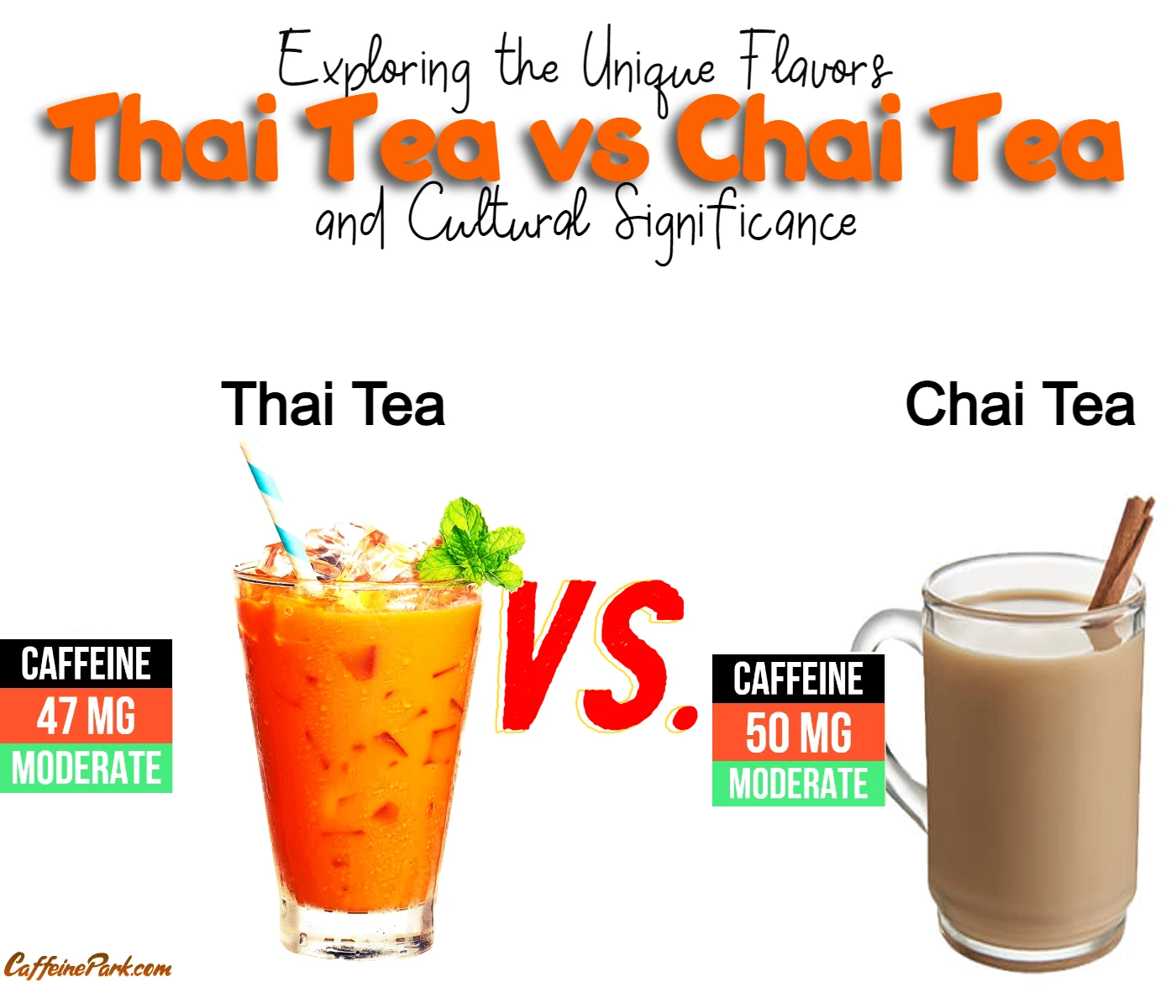Thai Tea vs Chai Tea

If you’re a fan of tea, you’ve likely come across two delicious and unique beverages – Thai tea and Chai tea. These two teas are made with black tea and a blend of spices and sweeteners, but they have their own distinct flavors and cultural significance.
In this blog, we’ll explore the difference between Thai tea and Chai tea. We’ll look at the ingredients used to make each tea, the flavors you can expect, the serving temperature, caffeine content, and cultural significance. Whether you’re new to tea or a seasoned tea connoisseur, you’ll want to stick around to learn more about these two popular beverages.
So, grab your favorite tea cup, settle in, and read to the end of this blog to discover the difference between Thai tea and Chai tea. Who knows, you may just find your new favorite tea to enjoy any time of the year!
Here’s a quick chart outlining the main differences between Thai tea and Chai tea:
| Thai Tea | Chai Tea | |
|---|---|---|
| Flavor | Sweet and creamy with hints of spices like star anise and cinnamon | Rich and spicy with hints of cardamom, cinnamon, and ginger |
| Serving temperature | Usually served cold with ice | Usually served hot with milk and sugar |
| Caffeine content | Contains caffeine from black tea | Contains caffeine from black tea |
| Origin | Originates from Thailand | Has a long history in India |
| Cultural significance | Popular in Southeast Asia, especially in Thailand | An important part of Indian culture |
Difference between Chai tea and Thai tea
What is Thai Tea?
Thai tea is a popular drink in Southeast Asia, especially in Thailand. It’s a blend of black tea, spices, and milk. The tea is brewed with star anise, cardamom, and cinnamon. It’s then sweetened with sugar and condensed milk, which gives it a creamy and sweet flavor.
The tea has a bright orange color and is usually served cold with ice. It’s a refreshing drink that’s perfect for a hot day. Thai tea is also sometimes served hot.
What is Chai Tea?
Chai tea is a spiced tea that originated in India. It’s made from black tea and a blend of spices such as cardamom, cinnamon, ginger, cloves, and black pepper. The tea is brewed with spices and milk, which gives it a creamy and rich flavor.
Chai tea has a brown color and is usually served hot. It’s a popular drink in India and is often enjoyed with snacks such as samosas and pakoras.
Ingredients
The main difference between Thai tea and Chai tea is the ingredients used to make them. While both teas use black tea, they have different spices and sweeteners.
Thai tea is made with black tea, star anise, cardamom, and cinnamon. It’s sweetened with sugar and condensed milk, which gives it a creamy and sweet flavor.
Chai tea, on the other hand, is made with black tea, cardamom, cinnamon, ginger, cloves, and black pepper. It’s sweetened with honey or sugar and often served with milk.
Flavor
Thai tea and Chai tea have different flavors due to the spices and sweeteners used in each recipe.
Thai tea has a sweet and creamy flavor with hints of spices like star anise and cinnamon. The tea is refreshing and perfect for a hot day.
Chai tea has a rich and spicy flavor with hints of cardamom, cinnamon, and ginger. The tea is warming and perfect for a cold day.
Serving Temperature
Another difference between Thai tea and Chai tea is the serving temperature.
Thai tea is usually served cold with ice. It’s a refreshing drink that’s perfect for a hot day. However, it can also be served hot if you prefer.
Chai tea is usually served hot. It’s a warming drink that’s perfect for a cold day.
Caffeine Content
Both Thai tea and Chai tea are made from black tea, which contains caffeine. However, the caffeine content can vary depending on the brewing method and the type of tea used.
If you’re sensitive to caffeine, it’s important to be aware of the caffeine content in both Thai tea and Chai tea. Thai tea contains approximately 47 mg of caffeine per 8 fl oz cup, which is slightly less than Chai tea, which contains around 50 mg of caffeine per 8 fl oz cup.
While these amounts may not seem significant, it’s worth noting that the caffeine content can vary depending on the brewing method and the type of tea used. Additionally, some pre-packaged versions of Thai tea and Chai tea may contain additional caffeine from added ingredients.
It’s always a good idea to check the caffeine content before consuming any beverage, especially if you’re sensitive to caffeine or have any health concerns. If you’re looking to reduce your caffeine intake, you can try brewing Thai tea or Chai tea with fewer tea leaves or opting for decaffeinated versions.
Cultural Significance
Thai tea and Chai tea have cultural significance in their respective regions.
Thai tea is a popular drink in Southeast Asia, especially in Thailand. It’s often enjoyed with meals or as a refreshing drink on a hot day. Thai tea is also sometimes used in desserts such as ice cream and pudding.
Chai tea has a long history in India and is an important part of Indian culture. It’s often served to guests as a welcoming gesture and is enjoyed with snacks such as samosas and pakoras.
Conclusion
In conclusion, Thai tea and Chai tea are two delicious and unique beverages. While they both use black tea as a base, they have different spices and sweeteners, which give them their distinct flavors. Thai tea is sweet and creamy with hints of spices like star anise and cinnamon, while Chai tea is rich and spicy with hints of cardamom, cinnamon, and ginger.
Another difference between the two teas is the serving temperature. Thai tea is usually served cold with ice, while Chai tea is usually served hot. Additionally, Thai tea is more popular in Southeast Asia, especially in Thailand, while Chai tea has a long history in India and is an important part of Indian culture.
If you’re a tea lover, you’ll definitely want to try both Thai tea and Chai tea to experience their unique flavors and cultural significance. Whether you prefer a cold and refreshing drink or a warm and cozy one, both Thai tea and Chai tea are great options to explore.
Alternative to Thai tea or Chai tea
If you’re looking for an alternative to Thai tea or Chai tea, there are plenty of other delicious tea options to choose from. Here are a few ideas:
- Green tea: Green tea is a popular choice for its health benefits and light, refreshing taste. It’s low in caffeine and high in antioxidants.
- Herbal tea: Herbal teas are made from a variety of plants and can offer a range of flavors and health benefits. Some popular options include chamomile, peppermint, and ginger.
- Rooibos tea: Rooibos tea is a caffeine-free herbal tea that’s naturally sweet and nutty. It’s a great option if you’re looking for a caffeine-free alternative to black tea.
- Matcha: Matcha is the powdered green tea that’s whisked into hot water. It’s high in antioxidants and caffeine and has a rich, earthy flavor.
- Bubble tea: Bubble tea, also known as boba tea, is a popular Taiwanese drink that features tea mixed with milk and sweetened with sugar. It’s often served with chewy tapioca pearls.
These are just a few options to consider, but there are countless varieties of tea to explore. Whether you’re looking for a caffeine-free option or a bold, flavorful brew, there’s sure to be a tea that suits your tastes.
FAQs
Yes, both Thai tea and Chai tea are made with black tea, which naturally contains caffeine. The amount of caffeine can vary depending on the type of tea and how it is prepared.
Thai tea originates from Thailand, while Chai tea has a long history in India and is an important part of Indian culture.
Thai tea is usually served cold with ice, while Chai tea is usually served hot with milk and sugar.
Yes, you can make both Thai tea and Chai tea at home. There are many recipes available online, and you can adjust the ingredients and sweetness level to your liking.
Read More:





